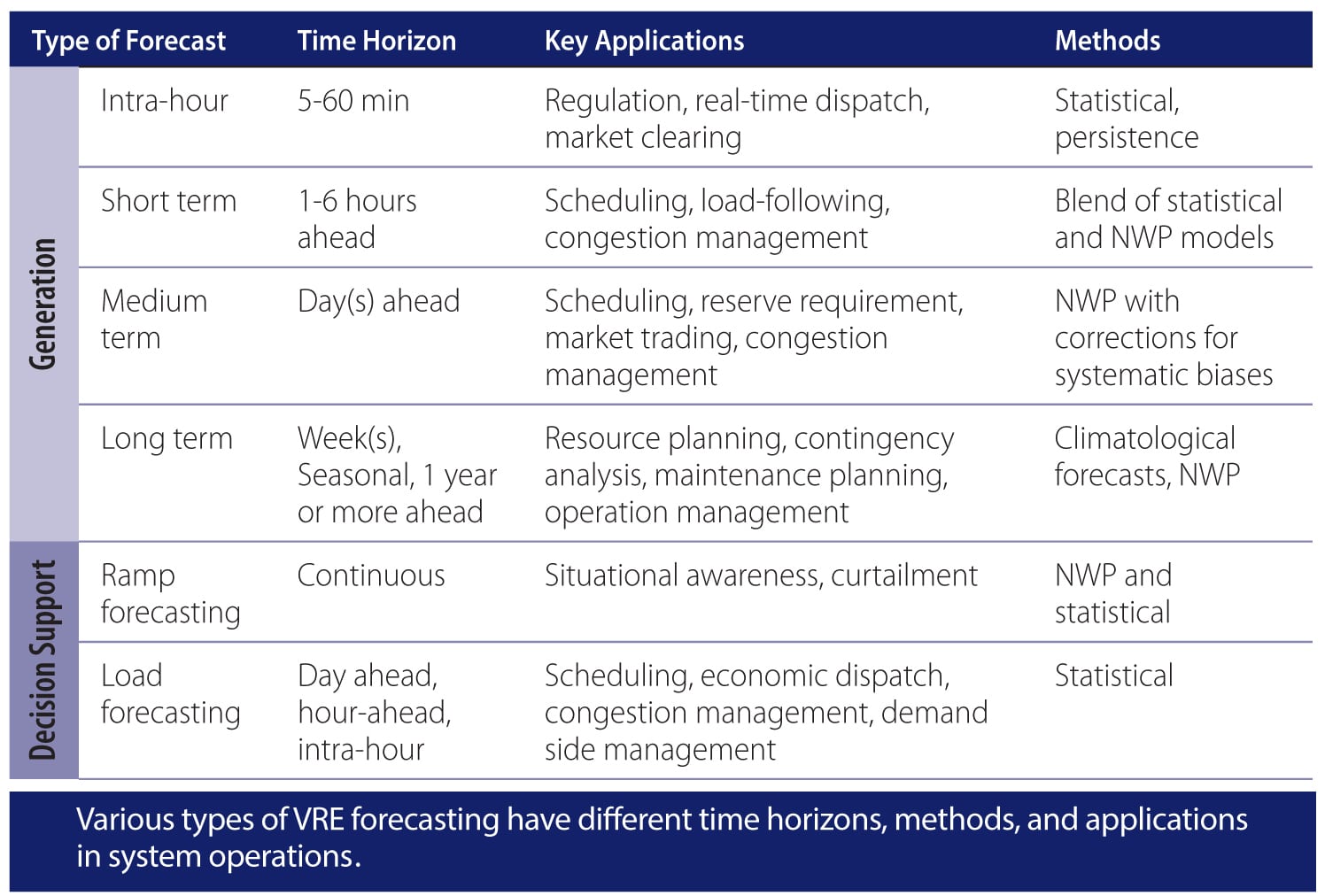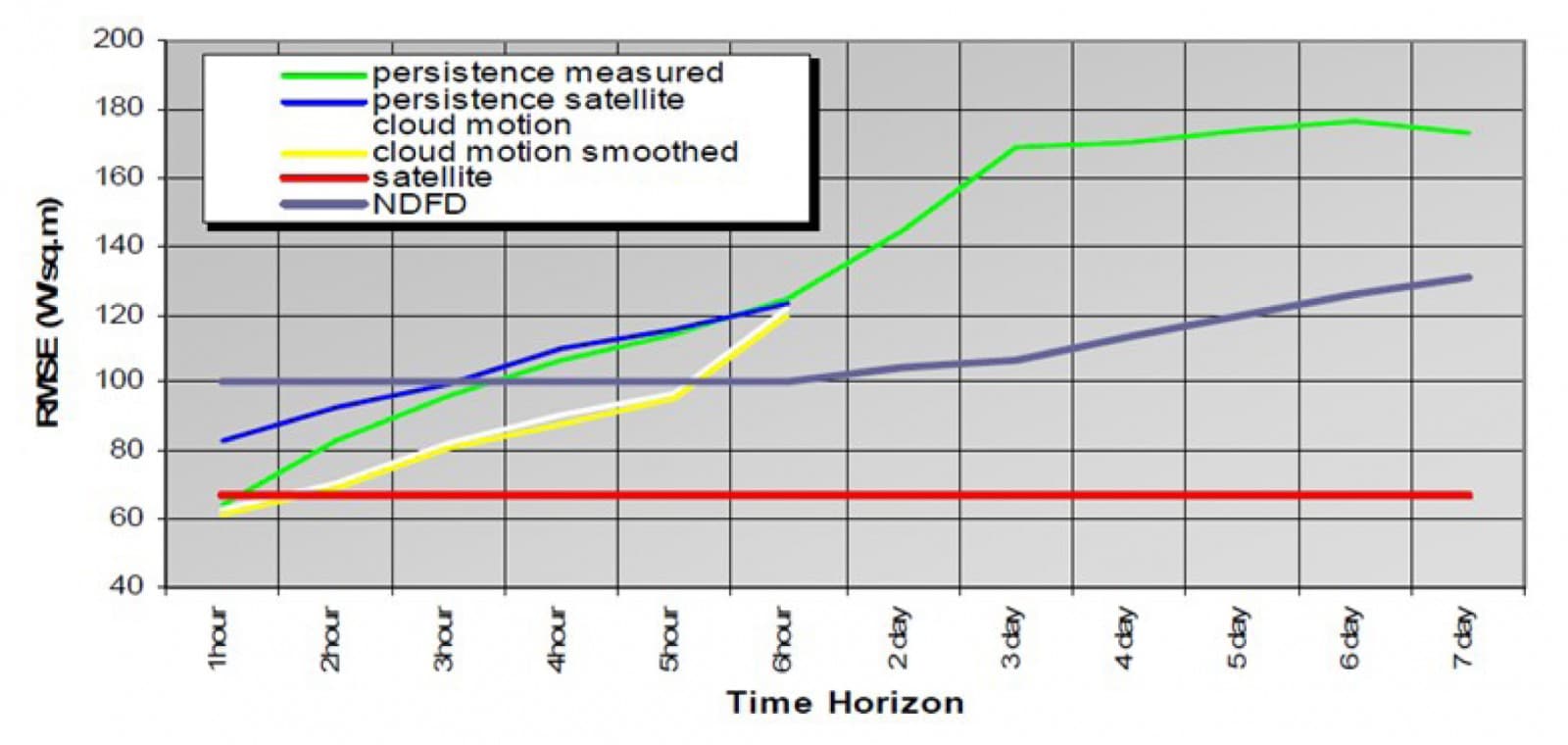The fines for imbalances on making of electric power by solar power-stations come into effect in Ukraine from 2020. In that behalf problem of generation forecasting and question of fines minimization for inaccuracy of such prognostications become actual again. Forecasting becomes a decision instrument for cost-justifiable integration of resources of variable renewable energy (VRE), such as wind and solar energy, into local, regional and national grids. How in the global scale they forecast generation from solar and wind stations, that is strongly related to changes of weather, that becomes more unforeseeable lately?
Problems of short-term prognostication of meteorological conditions
So, the question of ajustments of generation from RES and from traditional fuel sources consists of three parts: it is fair concordance of RES producer’s prognoses, taking into account interests of the third parties and reliable predictions of energy consumption, plus actual problems of short-term prognostication of meteorological (weather) conditions “on twenty-four hours advance basis”, that actually means generation prognostications by the hour. And it is the most “difficult” part of the problem.
It is necessary to make a reservation at once, that this problem is not solved reliably and exactly nowhere in the world. Whole mass of algorithms and software complexes is offered, international conferences are held on algorithms, debates are opened, new software products are promoted, but universally recognized “industry standards” for prognostication of VRE are still not present for today.
Except solving of mathematical design problems on weather processes and informational-calculating difficulties for weather prognoses drafting of such kind (the more with deviation within 5-10% limits, creation of very wide automatic stations-based network infrastructure is required for collection of meteorological data, that would automatically pass local atmosphere conditions indormation in on-line mode. And then these data need to be processed and distributed among local consumers of such information with exactness and regularity, as they need it.
To illustrate an example of the complexity of the task in generation prediction, let’s take a look on a fig. 1, where a screenshot of prognostication system is presented on American Xcel Energy RES-station within the limits of 36-hours planning horizon. Such depth of planning is considered optimal for “twenty-four hours advance” operational mode. On the basis of data collected from the weater data monitiring system, the system of company forecasts generation amounts automatically. Calculations in “twenty-four hours advance” mode include data on actual electric power production (green points), including the initial point of generation prognosis (continuous vertical line) and typical prognosis error for previous and on next seven days (shaded area). 10% error range (±5%) for prognostication itself, not even for actual deviation of generation from a prognosis (!), includes, as the best option, forecasting not further than 1,5 hours advance.
Is it necessary to plan and co-ordinate generation from different sources? Is it necessary to manage generation from RES? Undoubtedly, it is.
Prognostication of VRE influences on several operations, related to grid management, including planning, supervisory control, real-time balancing, reserve requirements to the grid and commands issuing for preliminary start (muffling) of compensative powers. Integrating prognoses from local producers of VRE, grid operators can foresee rapid changes of VRE generation, to economically balance energy consumption and pre-arranged generation for a day and within day period. It results in cost cutout on unrenewable fuel, in increase of grid reliability on the whole and in expenses minimization on energy acquisition from RES. It will help not only to balance the grid on power and voltage, but also will improve energy quality in electricity networks, make its frequency and phase changes better.

Methods of prognostication
Methods of prognostication are generally divided into two categories. Physical methods transform data about weather conditions (for example, temperature, pressure, speed and direction of wind, taking into account surface topography and obstacles) into numeric data (numerical weather prognostication, NWP) for the prognosis of specific local weather terms that can be further converted into prognoses on energy production. Statistical methods use statistical data in real time mode to get statistically reliable results on the basis of NWP models.
Prognostication of stability (persistence) is a simple statistical method, supposing, that present levels of generation will remain unchanging in short-term scope and they conform to mediated previous actual statistics upon this date and time. Persistent prognoses are often used as standard or base model for estimation of more advanced methods.
Prognosis error (also prediction error, forecasting error) is a difference between forecasted data and actual generation. Errors are used to calculate forecast precision, that allows system operators to forecast vagueness in planning and to compare different forecasting methods. Best prognostication “on a day advance”-systems provide errors within ±13 – ±15% limits. Three most widely used methods of precision measuring are:
- Middle bias error specifies, how systematic the system is forecasted with over- or under-estimation.
- Middle absolute error measures middle prognoses precision regardless of errors gradient.
- Root-mean-square minimum criterion error measures middle prognoses precision regardless of errors direction and appropriates relatively larger weight to large errors.
Factors, influencing on efficiency of hour-scale forecasting, include forecasting horizon, local weather terms (influencing on changeability of VRE resources), geographical scope, data availability (for example, amount, location, methods and reliability of provided information) and quality of data (for example, timing co-ordination, accuracy, laying out and correction on territory scope) et al.
Forecasting accuracy of VRE usually increases at shorter periods of getting current meteorological data. For example, for hour-scaled forecasting within ±5 % error limits you need to have data for prognostication with 15-minutes laying out, that in turn must use minimum 9 series of current data for calculations. So, actually, fresh data from weather stations must be provided and processed every single minute.
In a table. 1 (See pic. 2) typical terms and used methods of prognostication for VRE generation are shown, recommended by USAID Office of Global Climate Change:

“Excellent result”, in IEA opinion, for 0-5-6 hours advance forecasting horizons was received during a year on seven different sites (see pic. 3). When forecasting “on a day advance”, as shown on the picture, it means mean-root-square error from 70 to 130 W on every square meter of solar panel surface. For a typical 250 W panel (1,6 sq.м) deviation of generation forecasting can make from approximately 40% to over 80% from nominal value. It’s no way to say about forecasting accuracy within ±[5%; 10%]. Red line on pic. 3 shows reference “forecasting” from satellite during satellite image capturing. Prognoses of clouds motion up to 5 hours advance, received from satellite (yellow and white lines), happened to be better, than numeral weather prognostication from data of National Digital Forecast Database (NDFD) in USA. Numeral weather prognostication (NWP) has similar accuracy for forecast horizons from 1 hour to 3 days.

Surface systems of permanent monitoring of cloudiness and solar irradiation (so-called Sky Watchers) can make an alternative to satellite prognoses. But surface optical stations can not calculate local vector of clouds motion as well as satellite stations do, and forecast local cloud thickness well, because optical surface systems have much less sky review zone, than satellite observers do.
According to the researches results (IEA, Photovoltaic and Solar Forecasting: State of the Art, 2013), PV-generation forecasting accuracy also very depends on volatility of local weather conditions, that is especially noticeable in mountain areas. For example, research of prognostication during one year for 26 surface measuring stations in Spain showed, that local features of climate and relief strongly influence on prognoses accuracy. In this research indexes of prognoses accuracy (both RMSE and bias error) measured by identical system, appeared far more worse for stations in the north region of Spain compared to central and south regions of the country, where weather is less changeable. And relative mean square error (RMSE) for central European stations fluctuates from 40% to 60% as compared to results from 20% to 35% for Spanish stations.
RMSE is reduced by simultaneous accounting of monitoring data from maximum possible number of local “sky watchers”. So in the Japanese region of Kanto 64 local “Sky watchers” were unified into single research and information network, and prognostication accuracy succeeded to be 60% higher (coefficient of error reduction for the measuring devices network attained maximal value of 0,4, compared with relative error coefficient of 1 for point measuring). Also is turned out, that unification of 24 local systems in a district with an area of 100 kilometers х 60 kilometers made mean absolute error (MAE) for regional prognoses 22% below than MAE for prognoses from point monitoring stations. Total errors reduction of incorporated prognostication network made about 70% (coefficient of error reduction about 0,3).
According to IEA data, deviation of RMSE of best systems of “clever” prognostication from persistent model (taking into account long-term monitoring data) makes from 18-35% (Spain) to 68-75% (Switzerland, Belgium, Netherlands, Canada, USA).
***
It is necessary to acknowledge that in Ukraine now there is not any system of instant automatic monitoring of local meteorological data in online mode, suitable for hour-based and daily prognostication of PV-generation. Averaging of registered data of intrahour generation upon every date for few years can become the only method, taking into account data of current generation (“persistence”). More or less this method is useful at estimation of annual generation. However taking into account current weather volatility, accuracy of persistent method for “twenty-four hours advance” mode, especially in a local scope, doesn’t stand up to any critical judgement.
In Ukraine there is no system of automated processing and distribution of data among concerned parties (neither on generation prospects of market participants nor about weather conditions). There is also nothing about acknowledged and non-conflicting rules of concordance for generation amounts. There is no clear forecasting mechanism of energy consumption in local networks on the same hour-scope base. There is not even reliable statistics on RES in Ukraine. There is no solid infrastructure of stations for surface cloudiness monitoring, unified into coordinated informational network.
There is no permanent simultaneous satellite watching system to track motion and thickness of clouds above all territory of Ukraine. There is no publicly accessible National database for short-term prognostication of weather and local solar luminosity. There are no certificated software data complexes, that would be acknowledged by all market participants. The Law doesn’t give any clues about financial sources for creation and development of mandated systems of prognostication and accounting of VRE. There is no long-term experience of research and optimization for such systems.
And all these “no” are quite possible to continue and to expand…